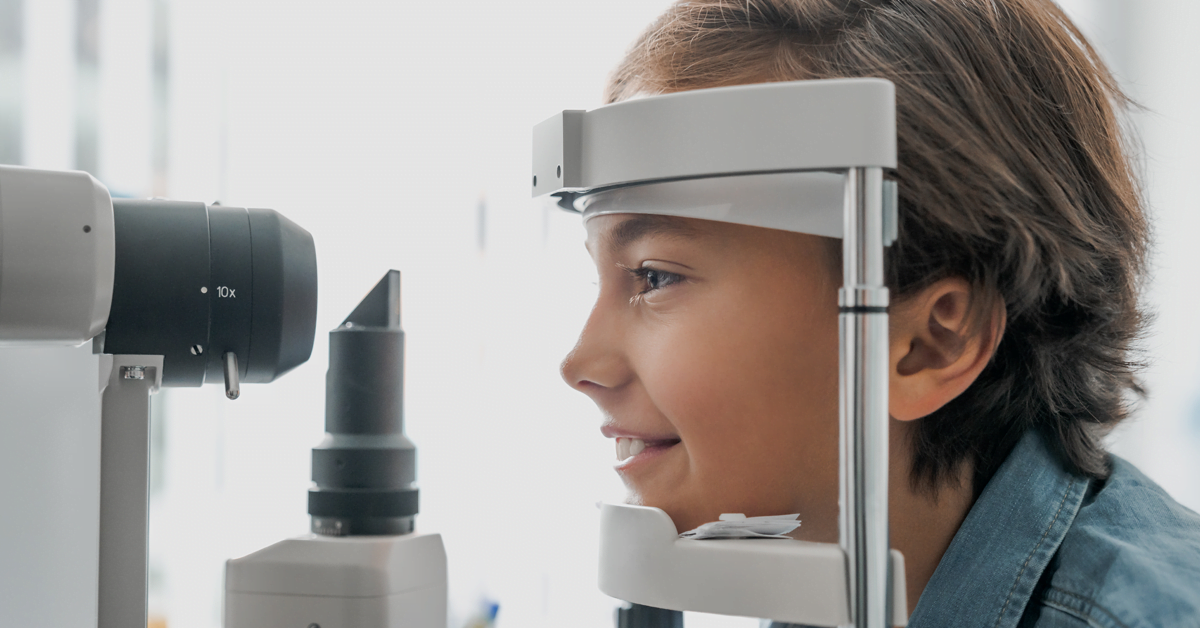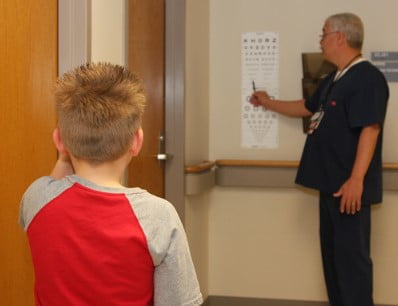
If you have children, you know how important it is to be vigilant about their health. However, unless you have a specific concern about your children’s vision, you may not take them for regular eye exams. These visual assessments and exams are crucial to your children’s development, especially since they may not be the best communicators and have difficulty explaining what’s wrong with their eyes. Unfortunately, since some common myths may prevent you from scheduling your children’s eye exams, it’s important to be aware of the difference between fact and fiction.
Myth: Children Need to Be Verbal to Have an Eye Exam
If you’re like most adults, you understand what occurs at an eye exam. You sit in a chair while the optometrist places lenses inside a contraption, and you discern the differences between the two lens options. Because children cannot express their preferences in this manner, you may believe your children cannot benefit from an eye exam.
Fortunately, optometrists have training and experience to test pre-verbal children so they can identify potential vision problems. They don’t need children to recite an alphabetic chart to determine if they can see. Technology has grown so that automation can provide accurate results. Many optometrists also recommend that you begin to form a relationship between your children and an optometrist when they’re as young as six months old.
Myth: Children Don’t Need an Exam Until They Start School

Although children indeed need an eye exam before entering elementary school, it’s best not to wait that long. On the contrary, many pediatricians recommend a comprehensive eye exam by the time a child turns one and then again before kindergarten. This is the guideline for children who don’t have any evident eye issues. Pediatricians do perform limited eye exams right after the child is born and during the child’s first few years. These basic assessments only look at developmental issues and may not catch specific visual problems.
Myth: Children Only Need Vision Screenings Administered by the School
While many schools provide a vision screening, you shouldn’t solely rely on this when it comes to your children’s vision. There’s a huge difference between a vision screening and a comprehensive eye exam administered by an optometrist. Vision screenings are designed to look for specific visual problems and provide parents with referrals for further assistance. Eye exams involve looking at a child’s eye health and vision and determining prescription strengths.
Myth: Children Who Can Look at Books Closely Don’t Need an Exam
You may think that your child can look at or read books just fine and doesn’t need an eye exam. Farsighted children can still focus well on books placed directly in front of them. They use an accommodative reflex to notice small details in books without any visual assistance. However, using this reflex can cause fatigue and eyestrain, and cause the eyes to eventually cross. Bringing them in for an exam can determine if they need any sort of prescription to see better.
Myth: Children Only Need an Exam Every Five Years
If your children have no obvious vision problems, you may believe you can wait five years for another exam. After all, if your children don’t complain about not being able to see the front of the class, you may believe their vision is perfect.
However, just as their bodies are growing exponentially during their younger years, so are their eyes. It’s best to schedule an eye exam every two years unless your children wear glasses. Those who wear corrective lenses should be seen every year. That way, the prescription strengths can be checked to ensure their eyes haven’t changed too much. Also, certain optometrists recommend more frequent visits if your children have certain developmental or visual health issues.
Myth: Children Who Don’t Squint Don’t Have Vision Issues
You may believe everything is fine if your children aren’t exhibiting any noticeable changes in their behavior. That’s not always the case. For instance, children can have a condition known as amblyopia, which is when one eye has significantly better vision than the other. When children have an issue with only one eye, they usually don’t exhibit behavior that will concern you.
Myth: Children Prescribed Glasses Will Become Dependent on Them
Once an optometrist prescribes glasses, you may believe that your children will become dependent on them. The opposite is the case. The glasses help to stabilize their vision and failing to wear them can cause their eyesight to deteriorate further. If your children receive prescriptions after their eye exam, make sure they continue to wear their glasses as advised.
Children may eventually outgrow farsightedness as they get older, but it’s more likely that they will need some sort of vision correction. Glasses don’t cure a child’s eyesight, but they do ensure that they can see clearer and their vision develops correctly.
Myth: Children Are Too Young for Contact Lenses
Contact lenses are an excellent option instead of glasses. Children and parents won’t have to worry about the lenses breaking due to sports, they won’t have to deal with foggy lenses due to cold weather, and some children may prefer the look of lenses compared to glasses. Children as young as eight can learn to insert and remove contacts, and most of the time they can learn as quickly as adults can.
However, just like adults, children shouldn’t rely solely on their contact lenses. For instance, they shouldn’t wear contacts when they have an eye infection or injury. Also, since children shouldn’t wear contacts more than 12 hours per day, they should have a spare pair of prescription glasses handy.
Now that you know the difference between a variety of myths and truths when it comes to children’s eye exams, it’s important to schedule eye exams for your children. These routine procedures can assess their vision to ensure optimal sight. Contact Northeastern Eye Institute to make an appointment. Our optometrists will test for eye diseases and visual acuity.